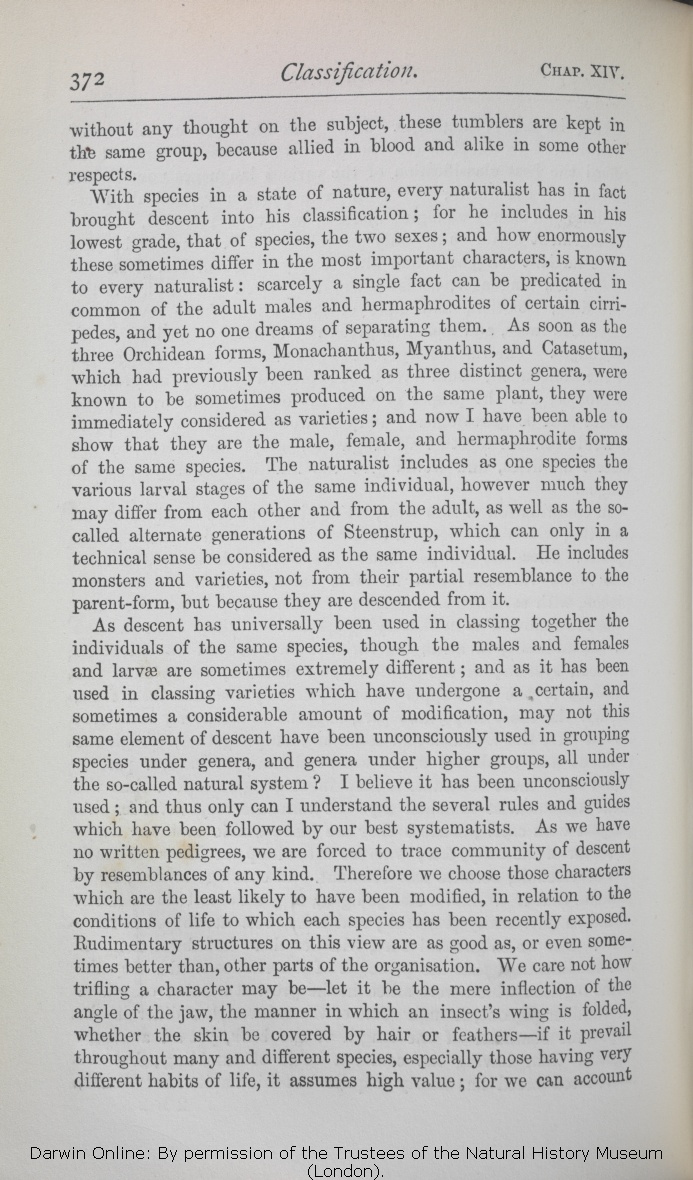without any
thought | thought 1869 1872 |
| reasoning or thinking 1859 1860 1861 1866 |
| 1 blocks not present in 1869 1872; present in 1859 1860 1861 1866 | | If it could be proved that the Hottentot had descended from the Negro, I think he would be classed under the Negro group, however much he might differ in colour and other important characters from negroes.
|
|
|
With species in a state of nature, every naturalist has in fact brought descent into his classification; for he includes in his lowest grade,
..| ..... 1869 1872 | | or 1859 1860 1861 1866 |
| ..... 1872 | | a 1859 1860 1861 1866 | | the 1869 |
| adult males 1866 1869 1872 | | males 1859 1860 1861 |
| ..... 1866 1869 1872 | | when adult, 1859 1860 1861 |
| Monachanthus, 1869 1872 | | Mona-chanthus, 1866 |
| are 1869 1872 | | really constitute 1866 |
| various 1869 1872 | | several 1859 1860 1861 1866 |
| adult, 1869 1872 | | adult; 1859 1860 1861 1866 |
| well as 1869 1872 |
| he likewise includes 1859 1860 1861 |
| he likewise does 1866 |
| monsters 1866 1869 1872 | | monsters; 1859 1860 1861 |
| and 1866 1869 1872 | | he includes 1859 1860 1861 |
| from their partial resemblance to 1869 1872 |
| solely because they closely resemble 1859 1860 1861 |
| because they may closely resemble 1866 |
|
|
As descent has universally been used in classing together the individuals of the same species, though the males and females and larvæ are sometimes extremely different; and as it has been used in classing varieties which have undergone a certain, and sometimes a considerable amount of modification, may not this same element of descent have been unconsciously used in grouping species under genera, and genera under higher groups,
all under the so-called natural system? | all under the so-called natural system? 1869 1872 |
| though in these cases the modification has been greater in degree, and has taken a longer time to complete? 1859 1860 1861 |
| though in these cases the modification has been much greater in degree, and has taken a longer time to complete? 1866 |
| ..... 1869 1872 | | thus 1859 1860 1861 1866 |
| thus only 1869 1872 | | only thus 1859 1860 1861 1866 |
| As we 1872 | | We 1859 1860 1861 1866 1869 |
| pedigrees, 1872 | | pedigrees; 1859 1860 1861 1866 1869 |
| are forced to trace 1872 |
| have to make out 1859 1860 1861 1866 1869 |
| which 1872 | | which, 1859 1860 1861 1866 1869 |
| OMIT 1872 |
| as far as we can judge, 1859 1860 1861 1866 1869 |
| modified, 1872 | | modified 1859 1860 1861 1866 1869 |
| insect's 1859 1860 1861 1866 1872 | | insects 1869 |
|









